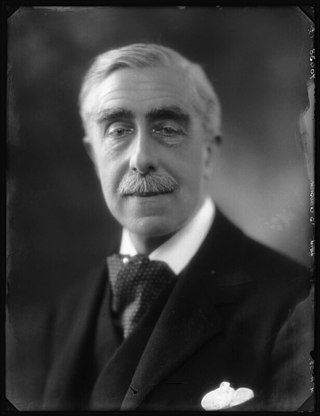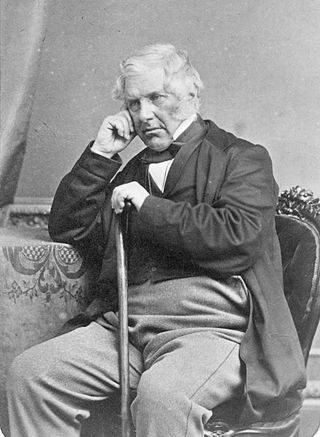Legal tender is a form of money that courts of law are required to recognize as satisfactory payment for any monetary debt. Each jurisdiction determines what is legal tender, but essentially it is anything which when offered ("tendered") in payment of a debt extinguishes the debt. There is no obligation on the creditor to accept the tendered payment, but the act of tendering the payment in legal tender discharges the debt.

Sir Edward William Stafford served as the third premier of New Zealand on three occasions in the mid 19th century. His total time in office is the longest of any leader without a political party. He is described as pragmatic, logical, and clear-sighted.

Charles Bathurst, 1st Viscount Bledisloe, was a British Conservative politician and colonial governor. He was Governor-General of New Zealand from 1930 to 1935.

Henry Sewell was a prominent 19th-century New Zealand politician. He was a notable campaigner for New Zealand self-government, and is generally regarded as having been the country's first premier, having led the Sewell Ministry in 1856. He later served as Colonial Treasurer (1856–59), as Attorney-General (1861–62), and twice as Minister of Justice.

Sir James McCulloch,, British colonial politician, was the fifth Premier of Victoria.

Sir Charles Sladen,, Australian colonial politician, was the 6th Premier of Victoria.

Uchter John Mark Knox, 5th Earl of Ranfurly, was a British politician and colonial governor. He was Governor of New Zealand from 1897 to 1904.

The pound was the currency of New Zealand from 1840 until 1967, when it was replaced by the New Zealand dollar. Like the pound sterling, it was subdivided into 20 shillings each of 12 pence.

Sir Charles Bullen Hugh Mitchell was a lieutenant-colonel in the Royal Marines, before joining the Colonial Service, in which he served in British Honduras, British Guiana, Natal. He then served as Governor of Fiji, of the British Colony of Natal & Zululand (1881–1882), and of the Straits Settlements.

William Mason was a New Zealand architect born in Ipswich, England, the son of an architect/builder George Mason and Susan, née Forty. Trained by his father he went to London where he seems to have worked for Thomas Telford (1757–1834). He studied under Peter Nicholson (1765–1844) before eventually working for Edward Blore (1787–1879). In 1831 he married Sarah Nichols, a Berkshire woman apparently fifteen years older than he was. A son was born in the first year of their marriage. In 1836 he returned to Ipswich to practise. Having worked at Lambeth Palace he had attracted the interest of the bishop of London, who now employed him independently designing churches and parsonages. These included three commissions for churches in Essex: St Lawrence, East Donyland; St Botolph, Colchester; and St James, Brightlingsea. The most remarkable of these is St Botolph's (1838) in white brick and Norman style. Apparently Georgian in plan and in its interior it strikes a Medieval note outside. St James (1836), also white brick and in the lancet style and resembling some of Blore's work, is very like St Paul's Church Auckland which Mason built a few years later. Perhaps because of economic hardship, perhaps because of ambition in 1838 the Masons emigrated to New South Wales.
The following lists events that happened during 1856 in New Zealand.
The following lists events that happened during 1855 in New Zealand.
The Constitutional history of Australia is the history of Australia's foundational legal principles. Australia's legal origins as a nation state began in the colonial era, with its legal system reliant initially upon a legal fiction of terra nullius to impose British law upon the colony of New South Wales. As the colonies expanded, Australia gradually began to achieve de facto independence. Over the years as a result the foundations of the Australian legal system gradually began to shift. This culminated in the Australia Act, an act formally ending legal ties with the UK.
Christchurch Country was a parliamentary electorate in the Canterbury region of New Zealand from 1853 to 1860. It was thus one of the original 24 electorates used for the 1st New Zealand Parliament.

Sir Saul Samuel, 1st Baronet was an Australian colonial merchant, member of parliament, pastoralist, and prominent Jew. Samuel achieved many breakthroughs for Jews in the colonial community of New South Wales including the first Jew to become a magistrate, the first Jew elected to parliament, the first Jew to become a minister of the Crown.
Charles Knight was a New Zealand doctor, public servant and botanist. He was born in Rye, Sussex, England in c. 1808. He studied medicine at University College, London from 1828 until 1830. In 1840 he became a Member of the Royal College of Surgeons of Great Britain and Ireland and a Fellow in 1869. Between 1830 and 1840 Knight worked as a doctor and spent time in America.

The Colony of New Zealand was a Crown colony of the United Kingdom of Great Britain and Ireland that encompassed the islands of New Zealand from 1841 to 1907. The power of the British government was vested in the Governor of New Zealand, as the representative of their monarch. The colony had three capitals: Old Russell in 1841; Auckland from 1841 to 1865; and Wellington, which was the capital until the colony's reorganisation into a Dominion, and continues to be the capital of New Zealand till the present day.
Colonial Bank of New Zealand was a trading bank run from Dunedin, New Zealand which operated independently for more than twenty years. A public company listed on the local stock exchanges it was owned and controlled by New Zealand entrepreneurs and not London or Australian bankers. Still subject to the same vicissitudes as its fellow colonial banks it was bought by the Bank of New Zealand in 1895.
The Colonial Land and Emigration Commission (CLEC), also known as the Colonial Land and Emigration Board, was a British government authority under the supervision of the Secretary of State for the Colonies that facilitated emigration within the British Empire. Established by a formal commission from Queen Victoria on 14 January 1840, the commission took over the responsibilities of two existing government offices, the South Australian Colonization Commission, and the Agent-General for Emigration.











